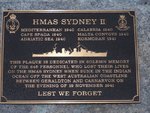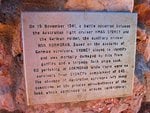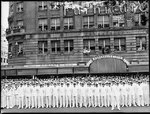diversdream
Airman
HMAS SYDNEY (ex HMS Phaeton)
Type - Modified Leander Class Cruiser
Sisters - HMA Ships Perth and Hobart
Pendant Number - 148 upto 1940 then Changed to D48 as of 1940 but Never Painted on Ship in Either Case
Builders - Swan, Hunter, and Wigham Richardson Ltd, Wallsend on Tyne England.
Laid down - 08 June1933 as HMS Phaeton
Launched - 22 September 1934 by Mrs SM Bruce, wife of the Australian High Commissioner, Engalnd.
Commissioned - 24 September1935 into the RAN under the Command of Capt John U P Fitzgerald RN
Displacement - 6830 Tons (7000 Tons Standard)
Tonnage - 6952 Gross Tons
- 3391 Net Tons
Length - 562ft and 3.6in Overall or from Bow to Stern only 530ft
Beam - 56ft and 8in
Depth (moulded) - 32ft
Max Sea Speed Achived - 32.5 Knots
(at Full Power During her Trials and Working up Period in England with her 'Commsioning Crew')
Armament -
8 x 6 Inch Breech Loading MK XXXIII Guns located in 4 Twin Turrets - A/B Forad and X/Y Aft.
Max Range 24 800 Yards
Max Elevation 60 Degrees
Each Turret had an Independent Shell Room while the 6 Inch Magazine's were Shared between the Forward and Aft parings of Guns with both Magazines Located Below the Waterline and Capeable of being Flooded in Any Emergency.
All Turrets were Powered by Electrical Systems using Individual Turret Pumps which were Located below each Gunhouse for whenever the Mounts were to be Trained onto target's etc.
All Shell and Cordite Hoists were Hand Operated With a well Trained Gun Crew able to Maintain a Rate of Fire of 8 Shells per 60 Seconds.
Each 6 Inch Shell Weighed in at 112 Pounds per Shell.
Main Armament was Controlled by Either the Director Controll Tower or what was Refered to as Local Control.
DCT Controlled meant that the Guns were fired Via an Electrical Siginal from the DCT All as One Salvo, while Local Meant that in effect Each Turret and Each Gun was Expected to Fire as an Individual Gun on their Own Target Bearings in their Own Time.
In the event of any kind of Loss of Electrical Power for Any Reason the Turrets had their Own Battriey Supply for Lighting inside the Turrets and also to Continue Firing the 6 Inch Guns.
At this Event All Training and Loading was Done by Manual Equipment inside Each of the Turrets.
Each Turret had its Own Local Sighting Equipment and was able to Fire Effectivley while Under the Control of the Turret Officer that Manned each Turret.
Type - Modified Leander Class Cruiser
Sisters - HMA Ships Perth and Hobart
Pendant Number - 148 upto 1940 then Changed to D48 as of 1940 but Never Painted on Ship in Either Case
Builders - Swan, Hunter, and Wigham Richardson Ltd, Wallsend on Tyne England.
Laid down - 08 June1933 as HMS Phaeton
Launched - 22 September 1934 by Mrs SM Bruce, wife of the Australian High Commissioner, Engalnd.
Commissioned - 24 September1935 into the RAN under the Command of Capt John U P Fitzgerald RN
Displacement - 6830 Tons (7000 Tons Standard)
Tonnage - 6952 Gross Tons
- 3391 Net Tons
Length - 562ft and 3.6in Overall or from Bow to Stern only 530ft
Beam - 56ft and 8in
Depth (moulded) - 32ft
Max Sea Speed Achived - 32.5 Knots
(at Full Power During her Trials and Working up Period in England with her 'Commsioning Crew')
Armament -
8 x 6 Inch Breech Loading MK XXXIII Guns located in 4 Twin Turrets - A/B Forad and X/Y Aft.
Max Range 24 800 Yards
Max Elevation 60 Degrees
Each Turret had an Independent Shell Room while the 6 Inch Magazine's were Shared between the Forward and Aft parings of Guns with both Magazines Located Below the Waterline and Capeable of being Flooded in Any Emergency.
All Turrets were Powered by Electrical Systems using Individual Turret Pumps which were Located below each Gunhouse for whenever the Mounts were to be Trained onto target's etc.
All Shell and Cordite Hoists were Hand Operated With a well Trained Gun Crew able to Maintain a Rate of Fire of 8 Shells per 60 Seconds.
Each 6 Inch Shell Weighed in at 112 Pounds per Shell.
Main Armament was Controlled by Either the Director Controll Tower or what was Refered to as Local Control.
DCT Controlled meant that the Guns were fired Via an Electrical Siginal from the DCT All as One Salvo, while Local Meant that in effect Each Turret and Each Gun was Expected to Fire as an Individual Gun on their Own Target Bearings in their Own Time.
In the event of any kind of Loss of Electrical Power for Any Reason the Turrets had their Own Battriey Supply for Lighting inside the Turrets and also to Continue Firing the 6 Inch Guns.
At this Event All Training and Loading was Done by Manual Equipment inside Each of the Turrets.
Each Turret had its Own Local Sighting Equipment and was able to Fire Effectivley while Under the Control of the Turret Officer that Manned each Turret.




